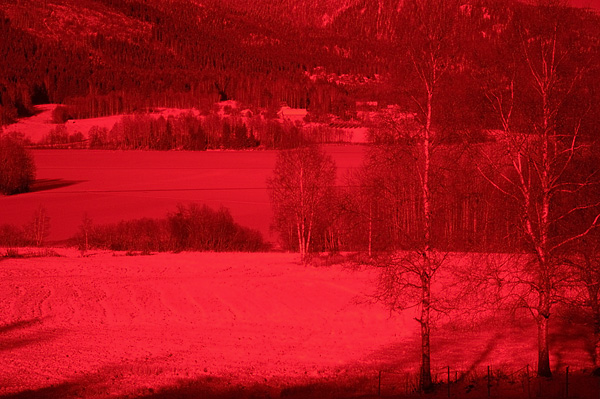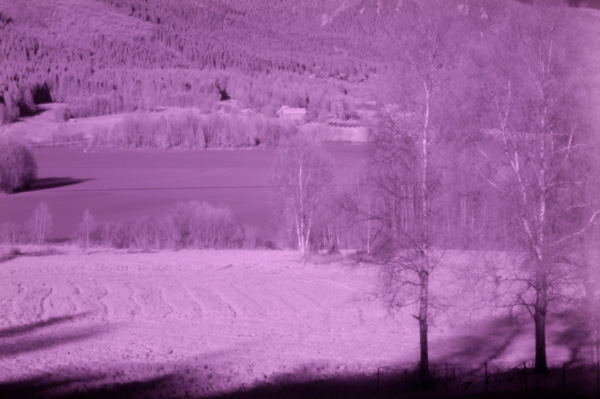| Nikon D2X Digital Camera
Reviewed |
|
|
| by Bjørn
Rørslett |
|
6.
Infrared (IR) photography with D2X
One pleasant surprise with
many of the digital cameras is their ability to record useful
imagery outside the visible spectrum. Typically, the sensitivity
to near-IR may be sufficiently high to allow IR photography not
only in bright sunlight, but also under less well illuminated
conditions. This is good news for any experimentally inclined end
user, but bad news for the camera manufacturer.
The camera designers
expressedly don't want IR to enter their cameras because IR will
reduce perceived sharpness, make skies look washed out or
experience colour shifts, produce blotched facial rendition, and
visually increase the adverse impact of chromatic aberration
(CA). Hence the anti-IR filter in front of the imaging chip
inside the camera, typically seen as a greenish sheen when the
CCD/CMOS chip is exposed to light. The anti-IR filter is combined
with an anti-aliasing (AA) filter in a filter pack, which may or
may not be removable.
Each generation of Nikon
D-series cameras has had its IR sensitivity decreased, or put the
other way, the efficiency of the filter pack has increased. Nikon
D2X is certainly no exception to this general trend. Thus, D2X
has nearly 3 EV less IR sensitivity than the D2H, when I shot IR test
scenes with each camera set up identically. This means you are
forever tied to using a tripod-mounted camera and additionally,
the ISO setting normally needs a healthy lift to keep shutter
speeds at a managable duration. I shot all IR images with D2X set
to 800 ISO equivalent.
With the Wratten 89B-type
filter I got excessively red images to indicate the red channel
carried the entire IR response. These images were so weird in the
colour rendition that Nikon Capture 4.2 refused to do a
"click-white" on them, and issued a warning about a
parameter out of range. I never had this happening before. The
denser Wratten 87 and 87C filter produced images with muted,
slightly pinkish colours to them and for these, Nikon Capture
allowed the "click-white" attempt.
Under sunny skies, the IR
response of D2X with 89B was down approx. 10 (!) stops compared
to daylight exposure. This is perfect from the Nikon engineers'
point of view and simply means they have done a good job in order
to keep the D2X free of IR-mediated hassles. For a keen IR
photographer on the other hand, this poor response, in
conjunction with the odd spectral balance, implies you should not
count on doing general IR work with D2X, this task is better left
to other models such as D100, D70, or D2H, all of which have 3-5
stops better IR response. Or if you are experimentally inclined,
get yourself an old D1 and strip out its internal filter pack to
give the camera a tremendous IR sensitivity (no less than + 14
stops compared to D2X).
Another feature with the IR rendition of
D2X is the rapidly declining response to the denser, Wratten 87
or 87C, filters. With D2H or D70, there is just a small penality
in terms of exposure elongation to pay for the nicer IR rendition
of the virtually black 87C filter. With D2X, the use of 87C will
cost you no less than 15 stops of increased exposure compared to
the daylight baseline. Moreover the images I got from D2X with
89B, 87, or 87C filtration tended to be slightly unsharp, again
in stark contrast to the nice and etchedly sharp IR images you
can lift off the D2H or D70.
 |
| Infrared
Landscape - I Nikon
D2X, UV-Nikkor 105 mm f/4.5 lens, Wratten 89B filter on
lens. No later change in colour balance.
1 sec exposure at f/15 @ 800
"ISO"
This exposure is 10 stops below the
reference in visible light. Although the red channel
isn't blown out, sharpness has suffered a great deal in
this image (no sharpening has been applied). You might of
course convert this image into a b/w rendition to get a
more pleasing appearance, but image detail lost is gone
forever.
|
 |
Infrared
Landscape - II
Nikon D2X, UV-Nikkor
105 mm f/4.5 lens, Wratten 87C filter on lens. No change
in colour balance afterwards.
8 sec exposure at
f/4.5 @ 800 "ISO"
This exposure is no
less than 15 stops below the reference in visible light.
The whole image looks very soft and image contrast is
down quite a bit, too. And yes, the focus on the lens has
been set properly for IR.
|
You should not do IR with D2X. Simple message, simple remedy: Just
don't do it. There are so much more
satisfying approaches to digital IR than those available with
D2X. On the other hand, the low sensitiivty to IR implies you may
get less problems with skin tones, which are unduly susceptible
to excessive IR.

